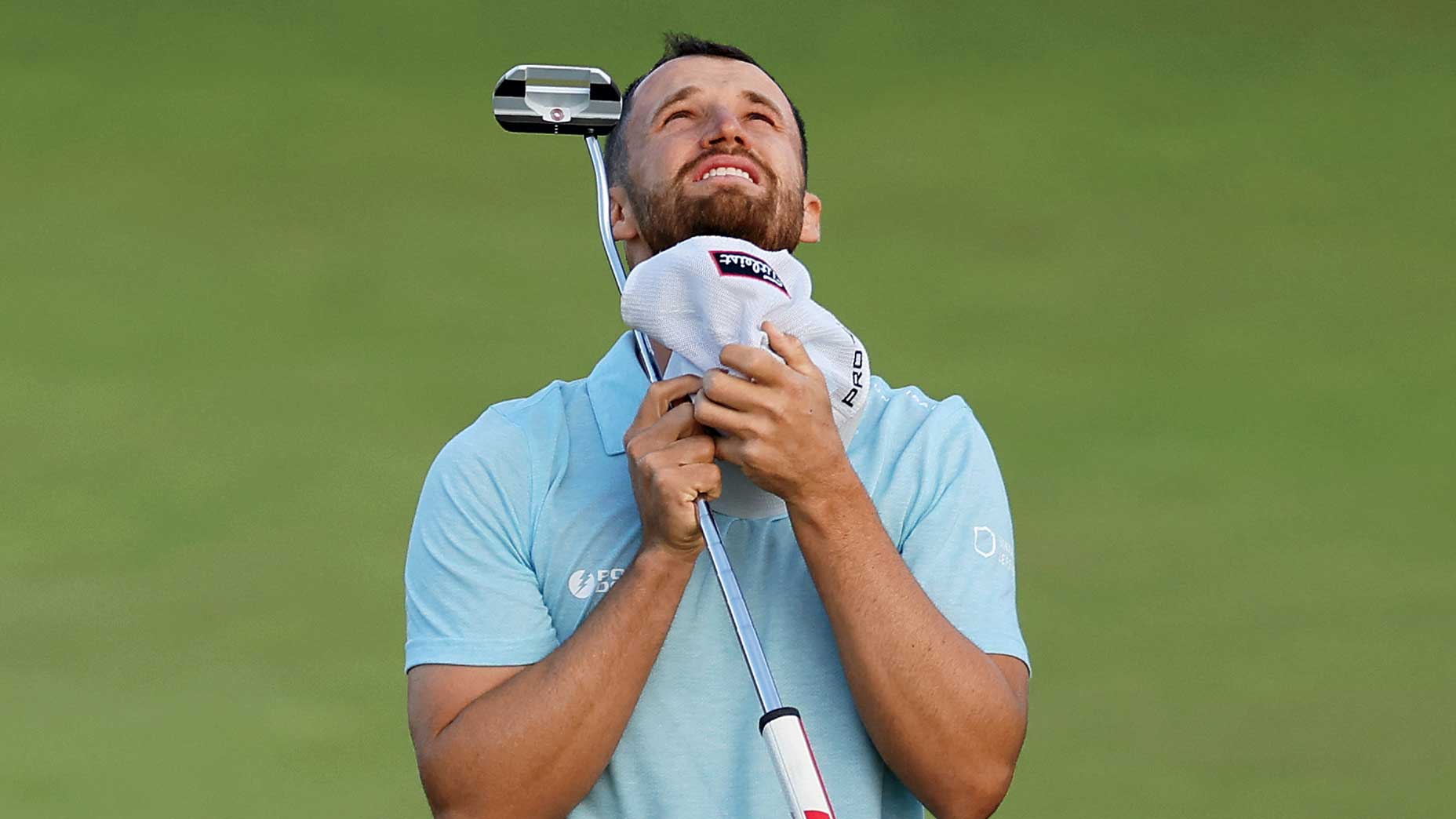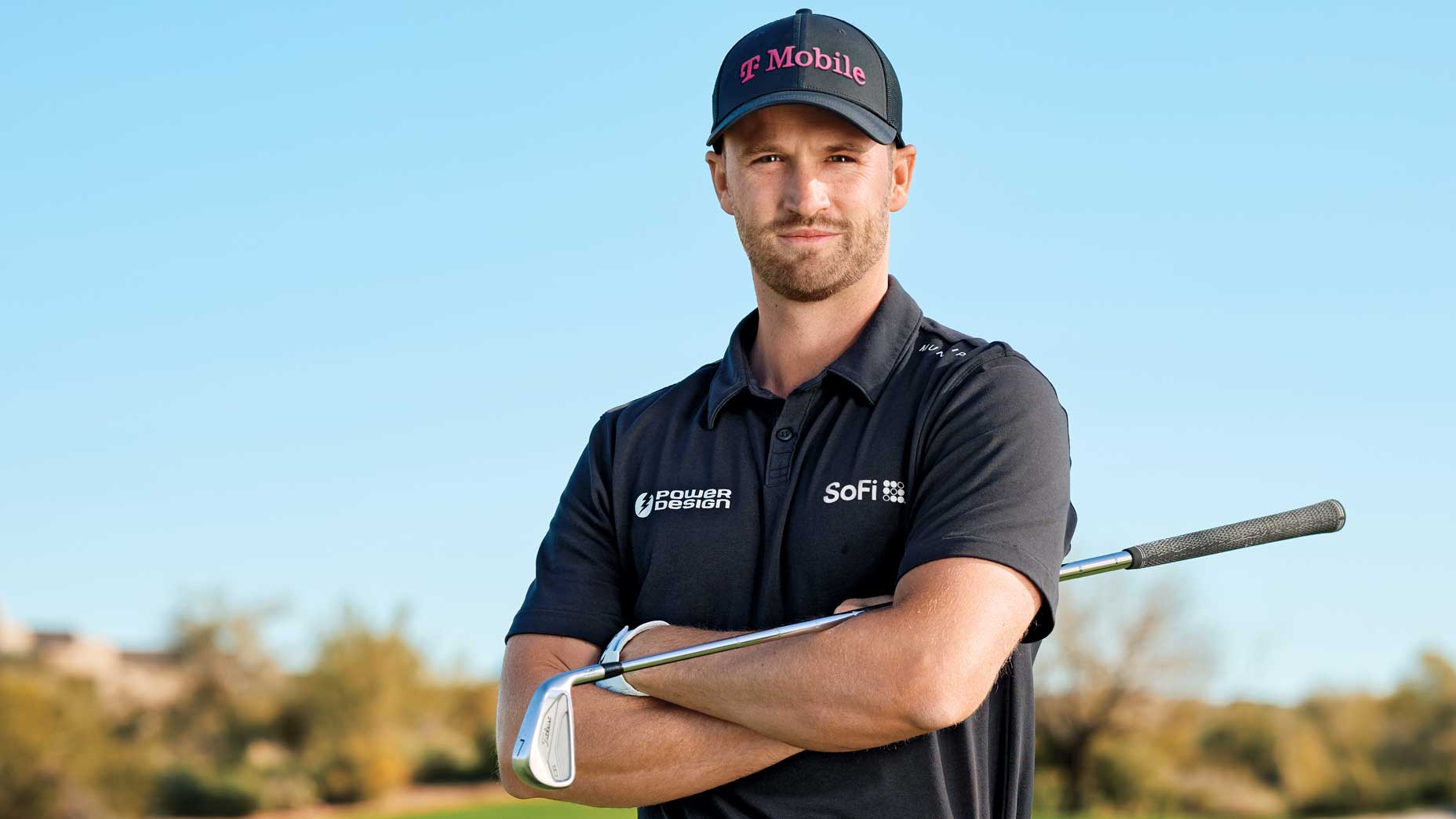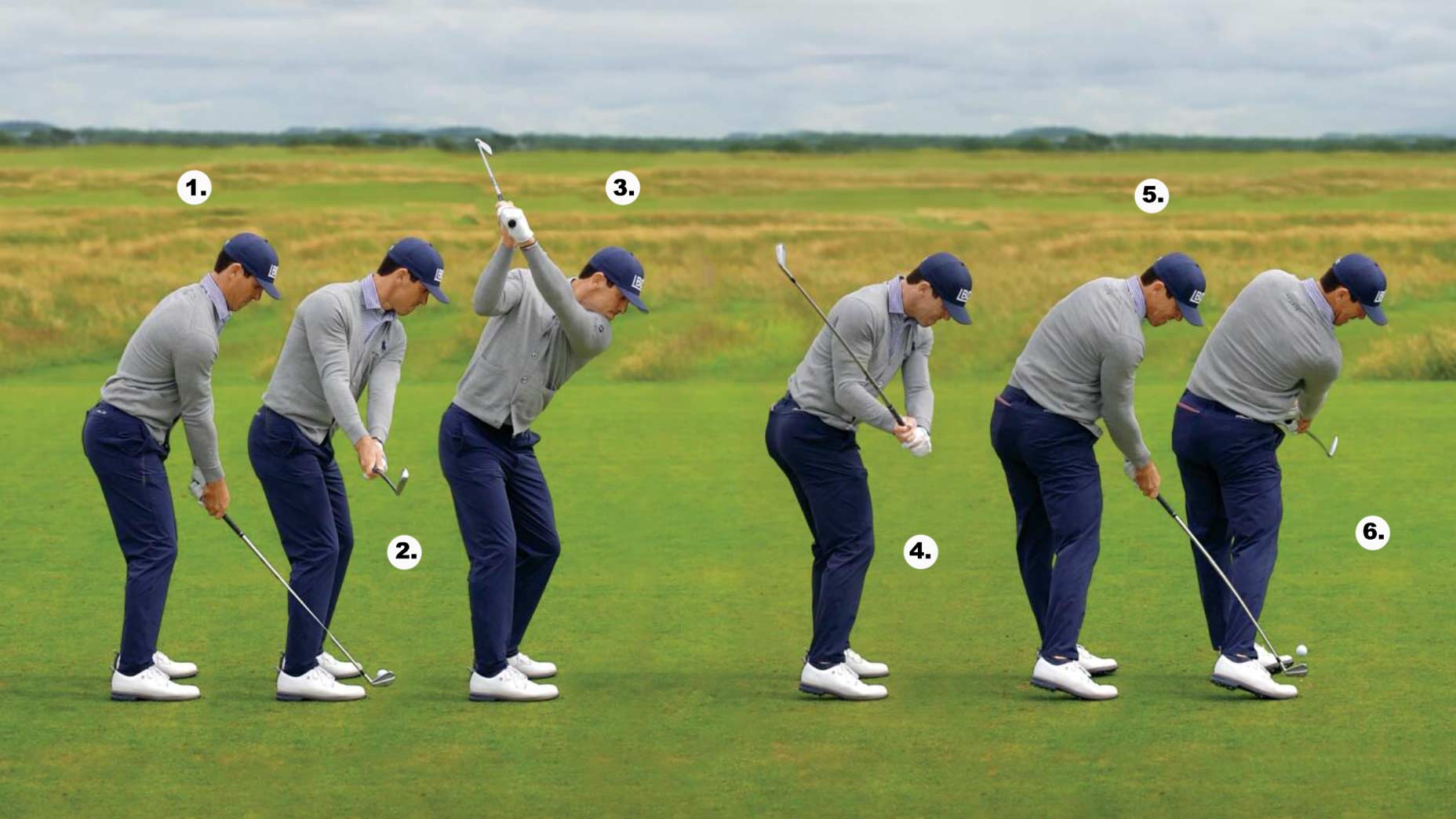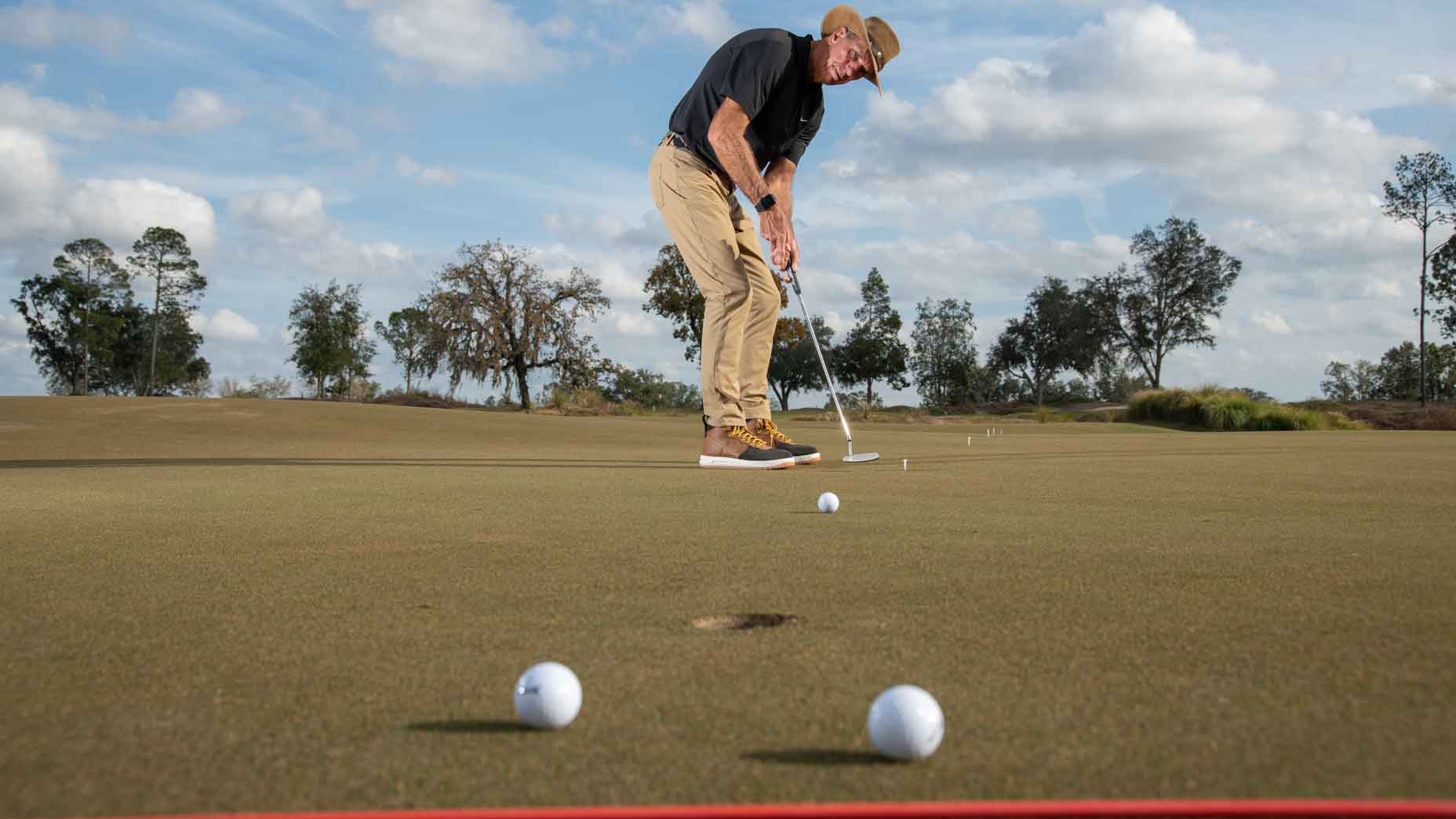This piece originally ran in the June issue of GOLF; Clark was our cover star.
—
WHAT’S THE DIFFERENCE?
These days, that’s the question Wyndham Clark gets asked most often. How’d he go from being just another Tour talent to being among its very best?
How’d he go from outside the top 300 in the world to inside the top three — in less than two years? How, at age 30, has he developed the ability to contend at golf ’s biggest events? How’d he go from that guy to this guy? What’s the difference?
Clark’s résumé is sparklier these days. His schedule is busier. He’s the No. 4-ranked player in the world. He’s No. 4 in the PGA Tour’s FedEx Cup standings. He’ll likely represent Team USA at the Olympics. He’s a star of an episode of Netflix’s Full Swing. He owns a Tour title — plus the course record — at Pebble Beach. Oh yeah, and he’s the defending U.S. Open champ.
In person, Clark is easy and friendly but notably direct. Firm handshake. Upright posture. Penetrating eye contact. Chest up. Chin up. He has the well-trimmed beard of a man with attention to detail, and the strong, slender build of a man with discipline. We’re in a side room at Troon North, a golf club in Scottsdale, Ariz., not far from Clark’s home. It’s an off-week in late March, but he’s still on. Augusta National scouting trip yesterday. Municipal clothing shoot tonight. And in between? A few questions about the difference and whether he’s surprised by how quickly this rise to stardom has happened.
Let’s take that last one first.
“No, I’m not surprised,” he says with certainty. “I just thought it would have happened earlier.”
GO BACK 27 YEARS and there’s Clark driving with his mom. He doesn’t remember all the details himself, but others have told the story enough times that now he knows it by heart. His dad is away. His brother’s just been born. And Wyndham, age three, is being a handful. His mother, Lise, desperate to get out of their Denver-area house, throws her kids in the car and off they go.
“She’s at a stop sign and sees Mountain View Range, which was this tiny little public driving range and putt-putt course,” Clark says. “And she took me there, asked the pro — she knew nothing about golf. But she said, ‘My son wants to hit some golf balls’ and got me a bucket. Had no clubs. They got me some. I hit one bucket and said, ‘Mom, can I hit another one?’ And it turned into, like, an hour and a half, two hours where I just sat there. It was a great reprieve for my mom. And, for me, that’s kind of when I fell in love with the game.”
GO BACK 13 YEARS and Clark, a high school senior at Valor Christian, is cleaning up at Colorado’s state championship, showing off a game he’s honed alongside his father, Randall, for years at Cherry Hills. He shoots an eight-under 64 in the first round and matches it in the second round. He wins by eight strokes. The Denver Post calls it “arguably the best two-day performance ever at a Colorado high school state championship event.”
Clark is satisfied. Sort of.
“I played good these two days, but I left a lot of shots out there and I have some stuff I need to work on,” he tells the paper.
This is his second state title; he’d won the championship in his sophomore year too. His freshman and junior years, he finished runner-up. He confesses those losses still sting. “It hurts me not to [have won] three or four,” he adds, “but it’s a big deal to win two, and not many people get the chance to do that.”
He has high expectations. They aren’t going away.
GO BACK 12 YEARS and Clark, competing in practice at Oklahoma State, hits a bad shot. He’s on the 13th hole of a qualifying round at their home course, Karsten Creek, in Stillwater. And with the mishit something inside of him snaps. He breaks his club in two, looking for an outlet for this white-hot shock of anger, but it isn’t enough, so he storms off the course, gets in his car and starts driving.
“I drove really fast, and for a long time,” Clark remembers.
In his eyes you can see how easily he returns to that moment, how it’s seared in his memory, a dividing line in his history of himself. The kid in the memory has just learned that his mother is battling breast cancer and he has no way to deal with it, no way to fend off the waves of sadness, frustration, rage. This isn’t a one-off; there have been other incidents and other outbursts. But this one’s different. He keeps driving.
He’s uncertain if he ever wants to go back — to school, to the game. “Obviously, there’s a lot of repercussions that go with that,” Clark says now. It’s hardly the end for him at Oklahoma State, but it’s evidence that the golf course is a turbulent place for him. At the urging of his coach, he reluctantly redshirts. He’ll have plenty of success at Oklahoma State but plenty more frustration too. Eventually he’ll lose his spot in the starting lineup and transfer.
Clark spends his final year of NCAA eligibility at the University of Oregon, where he’s seeking a fresh start. His new teammates haven’t seen his temper, haven’t seen him struggle, didn’t know him when — the summer before his second year at Oklahoma — he lost his mom. It’s a chance for reinvention.

GO BACK SIX YEARS and Clark, a 2018 rookie on the Web.com Tour, needs a caddie. After winning conference player of the year honors at Oregon, he’s a hotshot prospect coming out of college — but then spends his first pro summer mostly missing cuts on the PGA Tour. Suddenly it’s clear that none of this will click as immediately and easily as he’d like.
He knows who he wants on the bag — his assistant coach at Oregon, John Ellis, would be a perfect fit. But Ellis takes some convincing. He was impressed with Clark’s drive and determination from the minute he met him in Eugene, calling it unlike anything he’d ever seen. But caddying is an inherently unstable profession. It’s not until Clark works his way through the Web.com season and locks up his PGA Tour card that Ellis jumps aboard. But once he makes the leap, he’s all in.
“I think it’s a great combination of friendship and mentorship,” Clark says of his right-hand man. “He’s older than me. He was my coach. And in those key moments, both in life and on the golf course, he can put on that mentor coaching hat and say, ‘Hey, snap out of it,’ or give me words of encouragement that I really listen to. And then we have so much fun together. It’s not just a business relationship; we’re always messing around. We joke a lot. We play a lot of cards together. We vacation with our families together. We’ve become really close.”
Success — never mind stardom — doesn’t come quickly. Clark keeps his card four years in a row but can’t bust through to the next level; he never finishes higher than 64th in the FedEx Cup, misses nearly as many cuts as he makes and hovers well outside the top 100 in the world.
Clark still believes he has the physical tools — tons of strength, tons of speed, wicked touch around the greens — but he’s wild off the tee and his inconsistent iron play holds him back. He’s also quicker to anger on the course than he’d like. Quicker to anger than his team would like too. And when he does get a shot at big events, he doesn’t take advantage; in five major starts from 2020 through 2022, his best finish is T75. He bottoms out with a string of seven consecutive missed cuts in 2021. In mid-2022 he slips back outside the top 300 in the world.
All the while, Ellis sticks by his side.
“It’s not that he wasn’t good enough, but he expected to be good right away,” Ellis says on the phone. “And I think that added pressure and stress to his progress the first few years.”
Something had to change. Three somethings, in fact.
GO BACK TWO YEARS and you’ll find the moment that Clark takes control of his future.
Step one is getting new clubs. Clark, now an equipment free agent, prioritizes independent testing over chasing sponsorship deals and heads to True Spec Golf for a fitting.
“I tried every club under the sun, any and every manufacturer,” Clark recalls. He’s been using the wrong shafts, he discovers, and the Titleist clubs he comes away with are instant game changers. His driver flies straighter. His spin rates stabilize. He gives his bag a full overhaul and sees instant results. His stats tell the story.
Step two is owning his swing. After years of bouncing between instructors and philosophies, Clark decides to abandon altogether the idea of a single swing coach.
“It’s not for everybody, but I think some guys rely too much on someone to tell them what to do,” he says. For years he’s been in a cycle of dependence. He’d struggle, turn to his coach for answers and receive a solution that works on the range but doesn’t translate to the course, sending him back to the coach to look for more answers.
Now? “I’ll be at home, and I’ll get to work and find something that feels pretty good on the range. And then when I’m on the course, I’ll go, ‘Oh, yeah, that doesn’t work on the course.’ And so I’ll go back to the range and work on something that will actually work in competition.”
This doesn’t mean Clark doesn’t believe in swing coaches. He expects to work with more in the future. But he’ll take their answers and consciously make them his own.
That connects directly to step three: owning his mind. After all these years, Clark got tired of battling his thoughts. After some convincing from Ellis and his agent Rob Mougey, he agrees to meet with Julie Elion, beloved performance coach to Max Homa, among others. Once he gets over the stigma of asking for help, Clark takes on the training as if he’s hitting the gym.
“I get it. Everyone thinks working with a therapist means something’s wrong with you,” he says. “I was one of those people. I thought it made me look weak, but it’s amazing how much it’s made me stronger.”
Ellis noticed the change right away.
“There’s a calmness about him,” he says. “Obviously, the better you play, the more confidence you get. But earlier, if he had a good Monday, Tuesday, Wednesday, his expectations would get higher and the pressure would get higher too. Now he can play bad on a Tuesday and he’s got this process, these goals, these little things with his swing, and none of that changes. The consistency has helped.”
Joy follows. Wins do too.
GO BACK TO LAST SUMMER and see how Clark handles the U.S. Open. First, though, see how he handles the events that lead up to it, because Ellis says there was a clear progression. In contention on Sunday at the ’23 Valspar. A week later, in contention on the back nine in the Dominican Republic. Six weeks later, in the lead on Sunday at the Wells Fargo Championship, where Ellis says a gritty front nine shows Clark has what it takes to win. He makes bogey at No. 1. Some hard-working pars. But he bounces back, birdies No. 8 and takes control.
“He had this calmness, this ability to hit the shots under pressure, and he hung in there and battled,” Ellis says of that outward, even-par 35. “So that’s nine holes where I think his career really changed.”
Clark birdies four of the first six holes on the back and outduels Xander Schauffele for his first PGA Tour win.
Fast-forward a little more than a month to the U.S. Open at Los Angeles Country Club. See how he writes out his goals for the week, a directive from Elion. He shares them with Ellis too.
No. 1: Enjoy yourself on this beautiful golf course.
No. 2: Be cocky out there.
No. 3: Remind yourself of the first two.
Things look easy in an opening-round six-under 64. They still look manageable as he plays his way into a share of the 54-hole lead. They look tougher teeing off on Sunday, with blue-chip chasers like Scottie Scheffler and Rory McIlroy just ahead of him and fan favorite Rickie Fowler in the final pairing alongside him. But Clark sticks to his plan.
“Julie told me, ‘Every time you hear someone chant “Rickie,” think of your goals and get cocky and go show them who you are,’ ” Clark says post-round. “I did that. It was like 100-plus times today I reminded myself of the goals.”
There’s a moment that sticks out from the day, when Clark, stuck in a bush beside the green on the par-5 8th, swings and misses. It’s a moment that might have unraveled a younger version of himself.
“I’ve learned from a lot of mistakes I’ve made, and so has John. He said we’re fine,” Clark says later.
He regains his composure, takes his medicine, plays to the back of the green and gets up-and-down for bogey. That risk management clears the stage for later heroics, like the piercing 3-wood he hits into the 612-yard, par-5 14th, the shot of the tournament. Four holes later, he’s a U.S. Open champ.

STICK AROUND TO SEE WHAT’S NEXT. Intense pressure comes with trying to win your first major. But there’s pressure afterward too. Pressure to validate. Clark does so with a third- place finish at the Tour Championship. And again with his Ryder Cup debut. But when the new season begins and Clark shoots a course-record 12-under-par 60 at Pebble to win the rain- shortened AT&T by a shot? It signals he’s here to stay.
More signs follow. The 2024 PGA Tour calendar has been defined by Scottie Scheffler, who wins four out of five starts in March and April, including the Masters. Nobody can hang with him, but Clark comes the closest, finishing second at Bay Hill and the Players and third at the RBC. He’s still not satisfied.
“He wants more,” Ellis says with admiration.
“Consistency is probably the biggest thing,” says Clark. “I look at Scottie and he’s just so consistently in contention. Bad weeks are top 10s or 15s. That’s what the best players do.”
There’s an impulse to assert that Clark has fixed his fiery on-course disposition. But that was never the intention. Ellis likes the fire. Elion works with it. Clark draws on it. All the greats do.
So he’s still the same high-expectations golfer as the high schooler who shot 64-64 and left wishing he’d gone lower. But Clark’s banged his head against the wall enough, he says. He’s put in enough 10-hour days. The key now is working smarter. It’s refining and sharpening. It’s knowing himself.
What’s the difference? That’s the difference.
Lise used to tell her son, “Play big.” He listened. He’s still listening. Wynner is what she’d call him. It’s a name he’s already lived up to. The only question remains: How many times over?
Dylan welcomes your comments at dylan_dethier@golf.com.










